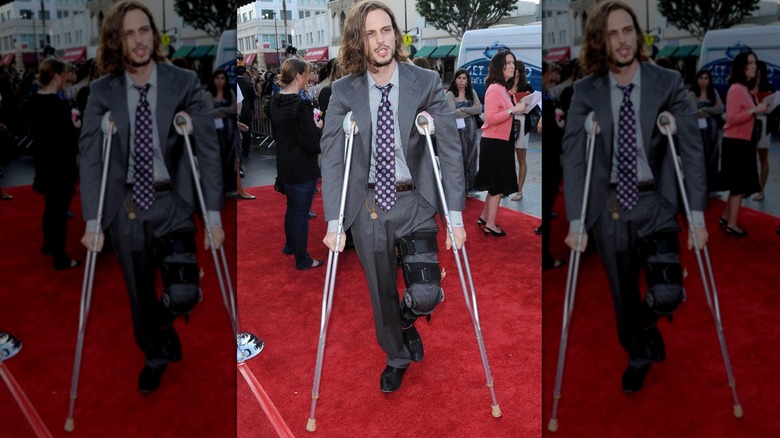All Of Matthew Gray Gubler's Health Issues Explained
You'll be hard-pressed to find someone more upbeat and positive than Matthew Gray Gubler. He's the very embodiment of what it means to have a sunny disposition. He became a household name starring in "Criminal Minds" as Dr. Spencer Reid, and media outlets that have had the pleasure of speaking to him can't stop gushing about Gubler's warm personality, bear hugs, and of course, his ability to find the silver lining in the most dire of situations.
Most longtime fans are aware that the actor's positive attitude has been put to the test a few times over the course of his career, thanks to some health issues that threatened to cut his acting days short. But Gubler isn't someone who gives up easily. When he broke his knee (more details on that later), he told Glamour in 2015, "I was loving it because I had my other leg!" It's this attitude that has inspired fans across the globe, and Gubler confessed that he believes his life's purpose is simply to make people happy, especially kids (something his work on "Alvin and the Chipmunks" most certainly managed to accomplish).
Gubler has a simple motto that's kept him going throughout his health challenges, telling Glamour, "I feel like if you wake up in the morning and can breathe, things are ... sweet. You have nothing to complain about. We're so lucky. You're alive, so enjoy it." And indeed, throughout his various health challenges, Gubler managed to practice what he preached.
Matthew Gray Gubler had achalasia when he started filming Criminal Minds
Few knew this at the time, but when Matthew Gray Gubler started filming "Criminal Minds" in 2005 he had a big health scare. While making an appearance on "The Late Late Show with Craig Ferguson" in 2012, Gubler shared that he was diagnosed with a scary condition while he was filming the show. "I had a weird thing called achalasia," he told Ferguson. "It's like a weird thing where your throat won't open, and so for 26 days I couldn't swallow anything. I had to lick butter to just sort of stay alive," he explained.
Gubler wasn't exaggerating, achalasia makes swallowing food almost impossible. "How I describe achalasia is to just imagine trying to push food through a straw that doesn't want to open at the bottom," Chief Medical Officer and physician at One Oak Medical, Jason Singh, M.D., told The List exclusively. "In medical terms it's a motility disorder of the esophagus which is the tube that connects your throat to your stomach."
Singh explained that achalasia either develops when the esophageal sphincter, which opens and closes to allow food to enter into the stomach, fails to open when food arrives or when the esophagus for some reason loses its motility, failing to move food along to the stomach. In both instances patients have trouble or are unable to swallow.
Achalasia is a rare but serious disease
If you've never heard of achalasia, you're not alone. Matthew Gray Gubler is one of very few people with this disease. Only one in every 100,000 U.S. citizens get diagnosed with achalasia annually, according to Cleveland Clinic. While this disease can present in children, these cases are even rarer, and adults aged between 25 and 60 are most likely to be diagnosed with this condition.
The Mayo Clinic notes that achalasia is often initially misdiagnosed as gastroesophageal reflux disease (GERD) because the two conditions share similar symptoms, but while GERD is caused by food pushing back up from the stomach, those with achalasia are experiencing symptoms from food pushing back up from their esophagus. Because achalasia makes swallowing difficult and inhibits the movement of food into the stomach, it can lead to a slew of other health issues, the most common of which is malnutrition and severe weight loss.
Unfortunately, Gubler's achalasia diagnosis also means he's more likely to develop esophageal cancer than someone who doesn't have the disease. Doctors encourage achalasia patients to get screened regularly for this cancer so treatment can be administered as early as possible, should tumors make an appearance.
The cause of achalasia is still unknown
Matthew Gray Gubler might have an impressive net worth, but unfortunately, no amount of money will be able to provide him with answers as to what caused his achalasia. Johns Hopkins Medicine explains that doctors are still baffled by the condition and are yet to figure out why some people develop achalasia. One popular theory is that the disease is the result of an autoimmune disorder. Doctors have found some evidence in nerve muscles responsible for esophageal function in affected patients that are indicative of an autoimmune response. Then there's also the fact that many patients with achalasia have existing autoimmune diseases, most often type 1 diabetes, uveitis, systemic lupus erythematosus, Sjögren's syndrome, or rheumatoid arthritis. It's not known whether Gubler has any of these diseases.
Another theory is that achalasia can be caused by viral and parasitic infections. Doctors have found that many achalasia patients have a history of such an infection, most commonly having been formerly diagnosed with either measles, herpes simplex virus, or human papillomavirus. Another possible explanation for the condition could be atrophy of nerve cells found in the esophageal tissue which enables motility.
Matthew Gray Gubler likely dealt with some very unpleasant symptoms
Achalasia symptoms are wildly unpleasant, to put it mildly, and it's a wonder Matthew Gray Gubler managed to continue filming. The Mayo Clinic explains that achalasia symptoms can start out pretty mild with minimal discomfort, which then increases in severity as the condition continues to develop. The most common symptom patients deal with is having trouble swallowing food. This leads to a feeling of having food and liquids stuck in their throat with it having nowhere to go. In some instances, patients may also experience food (and even their saliva) pushing back up from their esophagus. This can eventually lead to vomiting and other complications, like food ending up in the lungs, which can lead to pneumonia. Choking is also a risk, according to Johns Hopkins Medicine.
Other, less obvious symptoms might also present, including chest pains that are severe enough to disrupt sleep. Heartburn and coughing are also common symptoms, with the latter usually occurring at night.
Matthew Gray Gubler had various treatment options for achalasia to consider
We bet the unpleasant symptoms associated with achalasia can cause even the most positive of people like Matthew Gray Gubler to feel a little down, but luckily, treatments to ease symptoms do exist. Jason Singh, M.D., told The List that patients have an array of treatment options to consider, depending on their needs and the severity of their condition. "Most common is pneumatic dilation where a balloon is inflated inside the sphincter to stretch it," Singh explained, adding that Botox injections are another less invasive option, but not necessarily the most effective. "Botox injections can temporarily paralyze the sphincter, though effects are short-lived. There's also medications that have a similar approach," Singh said, explaining that surgery is also an option. Of course, with surgery, there are always risks, and Johns Hopkins Medicine notes that the procedure usually prescribed for achalasia, known as an esophageal myotomy, isn't always an option for patients.
The surgery, in simple terms, consists of cutting the problematic muscles to allow them to function normally again. This includes the muscles in the lower stomach, the esophagus, and the esophageal sphincter. The surgery can be performed using an endoscope or by making small incisions in the abdomen. This surgery is considered the closest treatment to a cure but pneumatic dilation remains the most common treatment, with 65% to 80% of patients finding relief after the procedure. The only downside is that the effects are sometimes temporary. It's likely Gubler opted for pneumatic dilation, given that it's not as invasive and doesn't require as much downtime as surgery.
Achalasia cannot be cured and needs lifelong management
Something many people might not know about Matthew Gray Gubler, is that he's still living with achalasia today. This rare disease unfortunately has no cure yet, and patients need to take steps to manage their symptoms for the rest of their lives. As the Mayo Clinic explains, the damage achalasia does to the esophagus is irreversible, and medical intervention and treatments are required to ensure patients can continue to live normal lives.
Cleveland Clinic notes that people like Gubler need to commit to routine doctor's appointments to ensure their esophagus stays in good shape. Because no existing treatment results in a complete cure, achalasia symptoms can reappear, and with doctors keeping a close eye, complications and relapses can be caught early and treated. At checkups, doctors usually look for signs of gastroesophageal reflux and whether food and drink are still entering the stomach successfully. These routine checkups can also help to detect esophageal cancer early, should it develop.
Achalasia could have a severe impact on Matthew Gray Gubler's career
Actors need their bodies to be in top shape in order to do their work well, and this includes their vocal cords. Because achalasia can cause gastroesophageal reflux disease (GERD), it can affect the vocal cords. When stomach acid continues to come into contact with the vocal cords, they can become irritated and inflamed, and in some instances, sustain permanent damage. Healthline notes that GERD can lead to chronic laryngitis, and patients could end up with a hoarse voice, difficulty speaking loud enough, and trouble enunciating their words, all things that can be a career killer for actors.
Jason Singh, M.D., told The List that achalasia can also cause people to feel the need to clear their throat repeatedly, which puts strain on the vocal cords and leads to hoarseness. "Actors often need to eat on set or maintain specific diets for roles, which could be complicated by swallowing difficulties," Singh added. Luckily, Gubler's achalasia hasn't affected his career so far, and Singh is optimistic that the actor will be able to continue his work in the future despite his achalasia diagnosis. "With proper treatment and management, many of my patients with achalasia lead normal productive lives," Singh said. "It's certainly a testament to Gubler's talent and perseverance that he's had such a successful acting career while managing this."
Matthew Gray Gubler also broke his knee during his time on Criminal Minds
Achalasia isn't the only condition Matthew Gray Gubler has had to deal with over the course of his acting career. While on a press tour for "(500) Days of Summer," Gubler severely injured his knee. "I just got a little too overzealous on the dance floor and managed to pretty much do something that most knee surgeons have never even thought possible or seen in their lives," Gubler told Who's News (via LiveJournal), explaining that, without the help of modern medicine, his leg would likely have been amputated. "It was about a seven-month adventure," he quipped. "I just basically dismantled the knee to the point where they were talking about experimental surgeries in Norway." Gubler had a miraculous recovery, but he had to walk with a cane for a bit and had a bit of a limp.
The injury was a very scary one, but in true Gubler fashion, the actor didn't take it too seriously when it happened, remaining stubbornly optimistic. In video footage (via YouTube) recorded after his mishap, he joked, "The weird thing is, I can't feel my toes." Gubler told Who's News that he's pretty certain his knee injury and its miraculous recovery will be recorded in some medical textbook for future generations to appreciate, but on a more serious note added he made the conscious decision to stay optimistic amid the injury. "I could take in the horrible reality, or realize that I'm lucky it wasn't my right leg, because at least I can drive," he said. "Bad things happen — it's how you deal with it is what makes it what it is."
Matthew Gray Gubler's positivity is what got him through the long recovery process
Matthew Gray Gubler (and his left knee) have undergone a stunning transformation over the years, but the actor admitted that the recovery process was anything but a walk in the park (no pun intended). Because his injury was so unique, doctors weren't sure how to fix it nor what type of rehab he needed to ensure a full recovery. "They screwed me back together, hoping it would work and thinking it wouldn't," Gubler told Who's News.
Like many other stars who have been open about their health issues, Gubler admitted that undergoing three surgeries took a toll on him. "No one knew what the protocol was for rehab. They basically had no plan to follow because it was sort of a unique injury," he explained, saying he underestimated how long his recovery would take. Gubler initially thought the injury would have a minimal effect on his work in "Criminal Minds," but ended up having to walk on crutches for 12 episodes. He'd hoped it would only be four. "It [was] a little hard to focus. It made the season incredibly tough just because when you're in a constant state of mind-numbing pain, it's not the easiest to chase criminals. But it made it good, and it was all for the best," he said.
In a 2015 Instagram post Gubler shared of himself walking on crutches and a phone pressed to his ear, he paid tribute to this difficult time in his life. "I needed 3 surgeries and was told I might never walk without a cane. I became a physical therapy pirate, conquered the impossible, and can now run faster than I could in high school," he wrote. "In this picture I was calling myself to remind myself that I will never be beaten."
Matthew Gray Gubler's injury had to be written into Criminal Minds
It might be safe to say that Matthew Gray Gubler was never the same again after starring in "Criminal Minds" thanks to all the adversity he had to overcome during his time on the show. While his achalasia diagnosis never affected him so severely that it had to be written into episodes to account for his symptoms, his knee injury couldn't exactly be hidden, and writers on the show quickly had to think up a quick plot twist for why Dr. Spencer Reid was on crutches. Their solution was to have him get shot in the leg at the beginning of the season.
Speaking to Who's News, Gubler said the show's creators didn't seem to be able to grasp the damage he'd done to his knee. "It was funny, they didn't really seem to believe me. No one believes I could have done what I did. I think to the day that people at 'Criminal Minds' have honestly no understanding of what kind of injury it was," he said. After his multiple surgeries, Gubler had strict instructions to refrain from anything resembling dancing or running, with the latter being a bit of a problem when your character's job is to chase after criminals. Apparently, the show's creators were a little baffled by this, with Gubler saying they seemed to think he just had some normal knee problems, not a unique injury that left doctors puzzled. "They've called my doctor, and I think they think my doctor is like a paid actor who's lying to them," he quipped.










